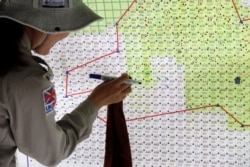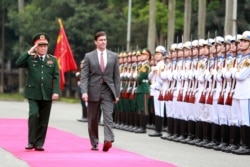Nguyen Hung usually tends to rice paddies in central Vietnam, unaware that, fewer than 30 centimeters below the soil, cluster bombs still lurk decades after the U.S. scattered them in the Vietnam War. But last month as the farmer stood in his lime-green field, an announcement blared over loudspeakers: he and his neighbors had to clear out, so a detonation team could move in.
A new report from Project Renew, the organization behind the detonation team, highlights how Vietnam has continued to clear bombs, land mines and other ordnance despite COVID-19.
Some of the work is funded by the United States, where officials ask how such use of weapons, which still kill Southeast Asians today, should inform the U.S. conflict in Iraq and Afghanistan.
Project Renew said it found 14 cluster bombs beneath Nguyen’s rice paddies last month. Many of them were 20- to 30 centimeters below the plants, according to Truong Cong Vu, a team leader on the project.
As nations wage war on COVID-19, Vietnam is cleaning up the remnants of an actual kinetic war. Project Renew adapted to the pandemic. It continued the work in February and March, while following guidelines from the state, which told people to wash their hands for 30 seconds and stay two meters apart to curb the spread of the coronavirus.
“Survey and clearance operators were required to keep a distance from each other while working in the fields, wear face masks and practice hygienic etiquette,” the organization said in a recent report, titled “Overcoming the Threat of UXO in the Shadow of COVID-19.”
Dirt and detritus
UXO refers to unexploded ordnance. It was scattered over Vietnam, Laos and Cambodia by U.S. bombers in the Vietnam War, at three times the volume of ordnance dropped in World War II. Southeast Asians died, as recently as 2018, by stumbling on unexploded weapons or unwittingly picking them apart for scrap metal.
Nguyen, the farmer, avoided that fate in April. As he stood aside in a cap and button-up shirt, the detonation team set about with its metal detectors, marked off problem areas with neon red and white tape, and blasted away the decades-old bombs. The controlled explosions sent up dirt and detritus, momentarily hanging in the air like a charcoal gray phantom.
“Thanks to the Renew/NPA teams, we now feel much safer to farm in our land,” the farmer was quoted as saying in a Project Renew report. NPA is the Norwegian People’s Aid, currently the project’s main partner.
In an echo of wartime rhetoric, the organization said it has been back to weapons clearance since April 20, “after a two-week stand down due to the COVID-19.”
“Project Renew resumed the important work to keep people safe from another virus that has infected Vietnam since the end of the war, and that is the scourge of explosive ordnance,” it said.
After the cease-fire
While U.S. troops exited Vietnam in 1973, the bombs they left behind still figure into bilateral relations. President Barack Obama counted demining among six defense priorities when he visited the nation in 2016.
On a visit last November, U.S. Defense Secretary Mark Esper touted efforts at cooperation between both sides, saying, “These include U.S. efforts to clean up dioxin contamination and to remove unexploded ordnance, along with Vietnam’s strong support for U.S. personnel accounting activities.”
In June 2019, staff at the U.S. Congressional Research Service (a department within the Library of Congress) sent legislators an analysis of the $400 million the U.S. has spent on UXO clearance in Southeast Asia. It said cleanup will probably involve several more decades and casualties. These human and dollar costs, as well as the long time that war legacies have lasted, are factors for legislators to consider, the report said.
The authors wrote the “continued presence of UXO in Southeast Asia” raises issues, including whether U.S. remedies have “lessons for similar activity in other parts of the world, including Iraq and Afghanistan; and, more generally, efforts to lessen the prevalence of UXO in future conflicts.”












